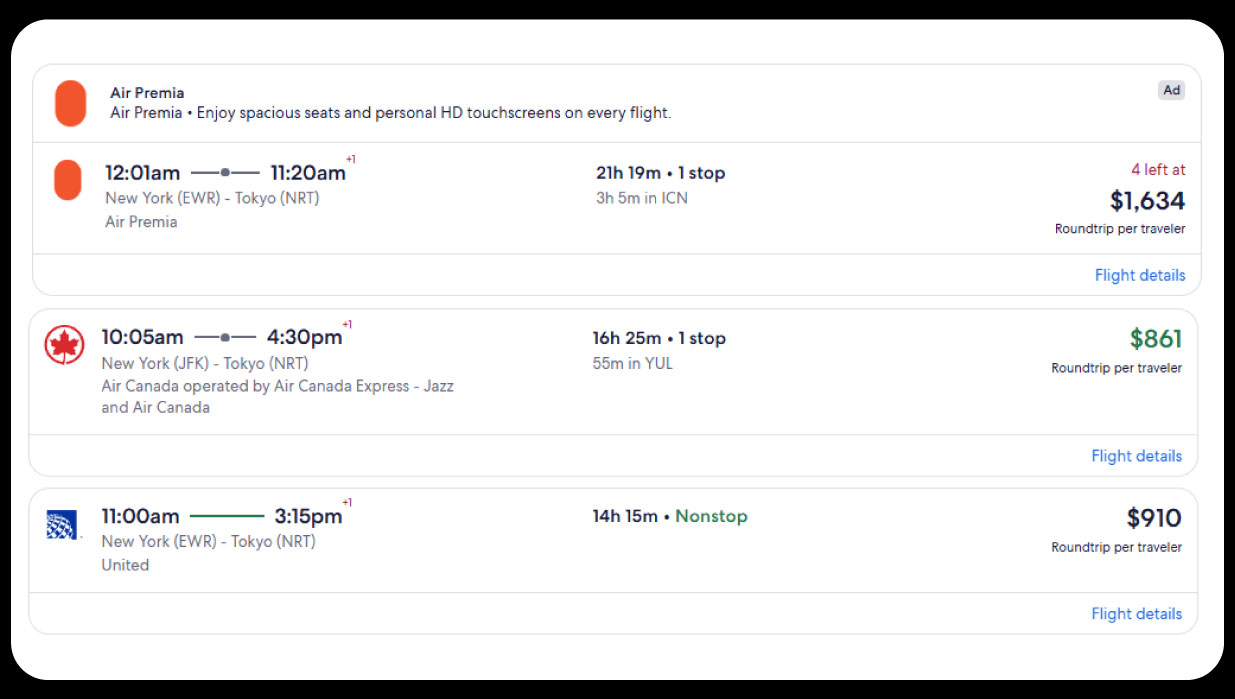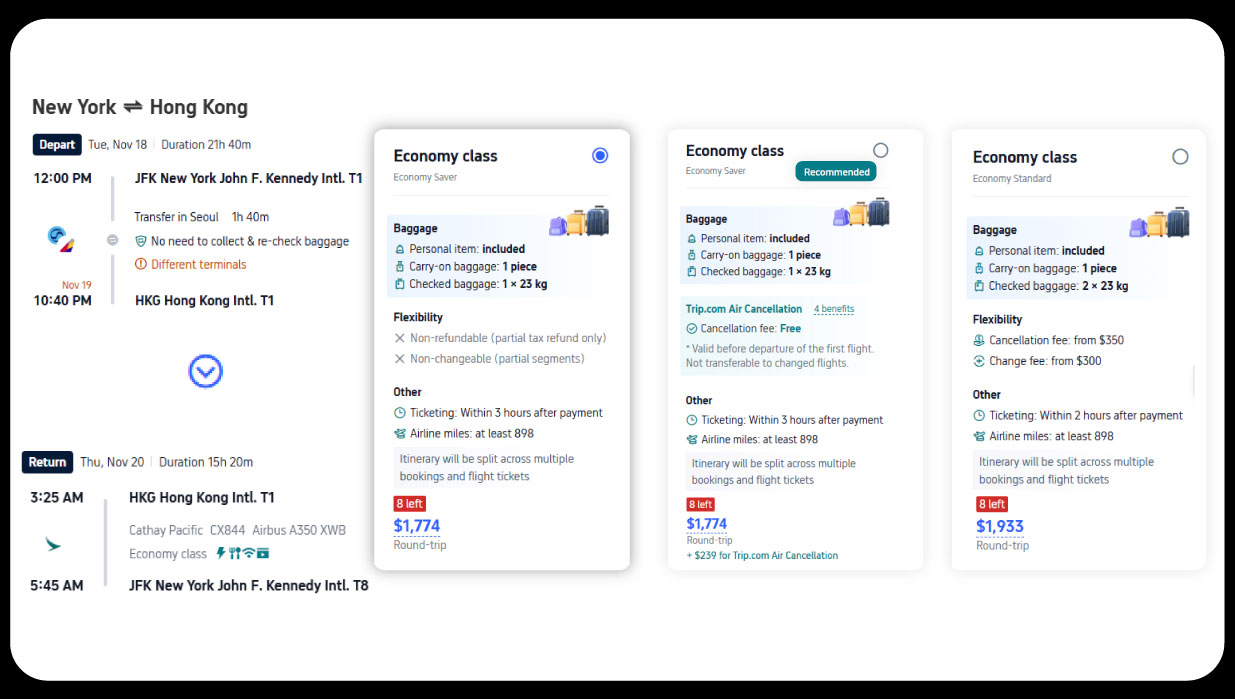
Try your luck — spin the wheel and unlock up to 30% OFF or exclusive freebies!

In the highly competitive aviation sector, airlines and travel companies increasingly depend on Airline Ticket Pricing Intelligence to maximize revenue and enhance the passenger experience. Leveraging big data analytics allows organizations to identify pricing patterns, monitor competitor fares, and anticipate market demand effectively. Advanced platforms now offer comprehensive flight pricing intelligence of USA, UK & Japan, providing stakeholders with critical insights for strategic decision-making in pricing, route planning, and marketing campaigns. By analyzing historical data and real-time trends, airlines can implement dynamic pricing strategies that respond to seasonal demand, special events, and competitor adjustments. Furthermore, modern technologies enable analysts to Scrape flight price prediction data from UK & Japan, ensuring forecasts are highly accurate and actionable. These insights support revenue optimization, operational efficiency, and improved customer satisfaction, helping airlines maintain competitiveness in an evolving global market. Overall, data-driven intelligence has become essential for strategic growth and profitability in aviation.

Airline ticket pricing is influenced by a complex combination of factors including seasonality, route demand, competitor pricing, fuel costs, and booking lead times. Accurate pricing intelligence allows airlines to:
Real-time monitoring and historical data analysis are key to understanding fare fluctuations. USA & UK route optimization analytics ensures that airlines allocate aircraft and resources efficiently, maximizing load factors and profitability.

Airline pricing data can be collected from multiple sources, including airline websites, global distribution systems (GDS), online travel agencies (OTA), and flight aggregators. By using method to Extract airline big data analysis, airlines and travel companies can generate actionable insights from massive datasets. Key aspects include:
Moreover, airfare Price monitoring tools help airlines detect sudden changes in market pricing, enabling swift adjustments to maintain competitiveness. Similarly, real-time flight price tracking allows dynamic pricing engines to update fares instantly based on demand, competition, and other market factors.
Analyzing route-specific data is critical for airlines operating internationally. Key metrics include average fare, occupancy rates, seasonal trends, and competitor pricing.
Table 1: Sample Airline Ticket Pricing Data (USD) – USA, UK & Japan Routes
| Route | Avg. Fare (USD) | Peak Season Fare (USD) | Avg. Occupancy (%) | Airline Count |
|---|---|---|---|---|
| New York – London | 720 | 950 | 82 | 6 |
| Los Angeles – Tokyo | 850 | 1,100 | 78 | 5 |
| Chicago – London | 710 | 920 | 80 | 4 |
| New York – Tokyo | 880 | 1,150 | 76 | 5 |
| London – Tokyo | 930 | 1,200 | 79 | 4 |
From this table, it’s clear that long-haul international routes such as New York–Tokyo and London–Tokyo have higher fares due to distance, fuel costs, and demand. Seasonal peaks also influence pricing significantly.
Table 2: Flight Price Monitoring Insights (Sample Data)
| Airline | Route | Avg. Fare (USD) | Lowest Fare (USD) | Highest Fare (USD) | Price Change % Last Month |
|---|---|---|---|---|---|
| Airline A | New York – London | 720 | 680 | 950 | +5% |
| Airline B | Los Angeles – Tokyo | 850 | 800 | 1,100 | +7% |
| Airline C | Chicago – London | 710 | 690 | 920 | +3% |
| Airline D | New York – Tokyo | 880 | 840 | 1,150 | +6% |
| Airline E | London – Tokyo | 930 | 890 | 1,200 | +4% |
The above insights help airlines understand market volatility and adjust pricing strategies accordingly. Using flight route comparison of USA, UK & Japan, analysts can identify profitable routes and adjust seat allocation to match demand.
Airline route planning involves more than just pricing analysis. Factors such as airport fees, fuel costs, seasonal passenger demand, and competitor presence are considered. Airline Route Optimization Report 2025 provides a forward-looking perspective on expected passenger flows, revenue potential, and cost efficiency.
Key benefits of route optimization include:
In combination with travel data scraping API, airlines and travel platforms can automate the collection of real-time fares and historical trends, providing a continuous flow of actionable insights.

While pricing intelligence is valuable, airlines face several challenges:
Despite these challenges, leveraging structured airline ticket data allows travel companies to enhance revenue, improve customer experience, and stay ahead of competitors.
Airline ticket pricing intelligence is a critical tool for airlines, travel agencies, and market analysts. By analyzing historical fares, monitoring competitor pricing, and predicting demand, stakeholders can make informed strategic decisions. Technologies such as Travel & Tourism App Datasets allow consolidation of flight and booking information for comprehensive analytics. Similarly, Travel Data Extraction Services ensure continuous access to high-quality, actionable data. Finally, integrating insights through a Travel Data Scraper streamlines reporting, forecasting, and optimization across global airline routes.
Experience top-notch web scraping service and mobile app scraping solutions with iWeb Data Scraping. Our skilled team excels in extracting various data sets, including retail store locations and beyond. Connect with us today to learn how our customized services can address your unique project needs, delivering the highest efficiency and dependability for all your data requirements.
We start by signing a Non-Disclosure Agreement (NDA) to protect your ideas.
Our team will analyze your needs to understand what you want.
You'll get a clear and detailed project outline showing how we'll work together.
We'll take care of the project, allowing you to focus on growing your business.